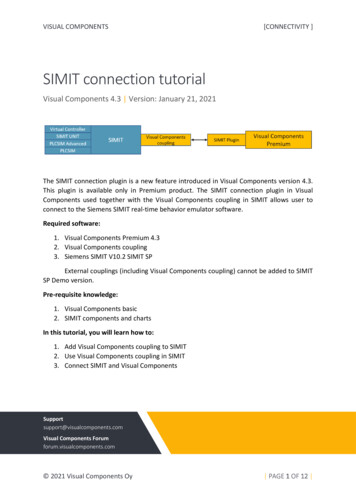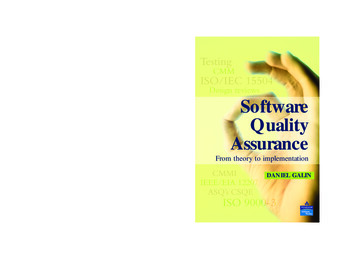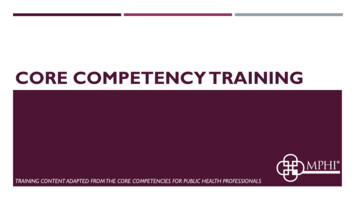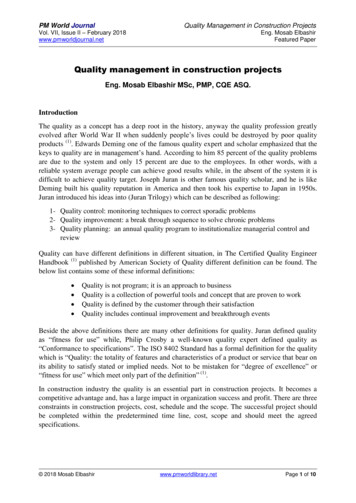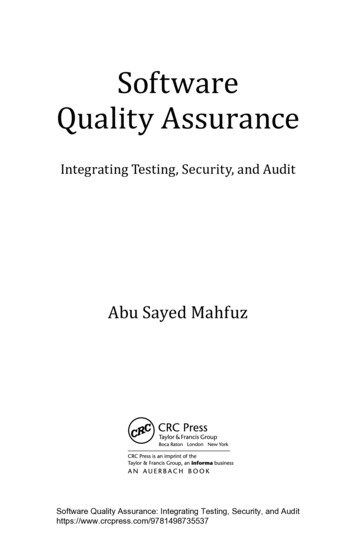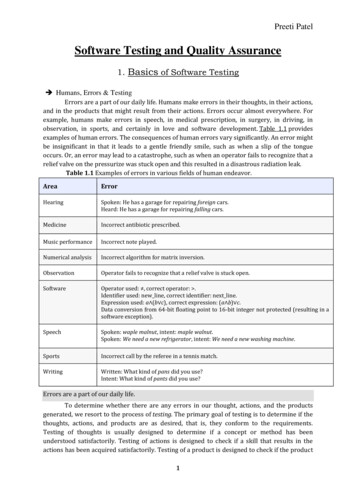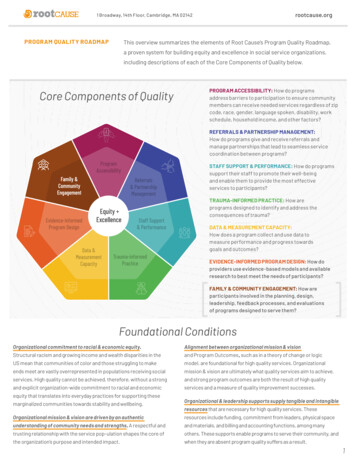
Transcription
rootcause.org1 Broadway, 14th Floor, Cambridge, MA 02142PROGRAM QUALITY ROADMAPThis overview summarizes the elements of Root Cause’s Program Quality Roadmap,a proven system for building equity and excellence in social service organizations,including descriptions of each of the Core Components of Quality below.Core Components of Quality ROGRAM ACCESSIBILITY: How do programsPaddress barriers to participation to ensure communitymembers can receive needed services regardless of zipcode, race, gender, language spoken, disability, workschedule, household income, and other factors?REFERRALS & PARTNERSHIP MANAGEMENT:How do programs give and receive referrals andmanage partnerships that lead to seamless servicecoordination between programs?STAFF SUPPORT & PERFORMANCE: How do programssupport their staff to promote their well-beingand enable them to provide the most effectiveservices to participants?TRAUMA-INFORMED PRACTICE: How areprograms designed to identify and address theconsequences of trauma?DATA & MEASUREMENT CAPACITY:How does a program collect and use data tomeasure performance and progress towardsgoals and outcomes?EVIDENCE-INFORMED PROGRAM DESIGN: How doproviders use evidence-based models and availableresearch to best meet the needs of participants?FAMILY & COMMUNITY ENGAGEMENT: How areparticipants involved in the planning, design,leadership, feedback processes, and evaluationsof programs designed to serve them?Foundational ConditionsOrganizational commitment to racial & economic equity.Alignment between organizational mission & visionStructural racism and growing income and wealth disparities in theand Program Outcomes, such as in a theory of change or logicUS mean that communities of color and those struggling to makemodel, are foundational for high quality services. Organizationalends meet are vastly overrepresented in populations receiving socialmission & vision are ultimately what quality services aim to achieve,services. High quality cannot be achieved, therefore, without a strongand strong program outcomes are both the result of high qualityand explicit organization-wide commitment to racial and economicservices and a measure of quality improvement successes.equity that translates into everyday practices for supporting thesemarginalized communities towards stability and wellbeing.Organizational & leadership supports supply tangible and intangibleresources that are necessary for high quality services. TheseOrganizational mission & vision are driven by an authenticresources include funding, commitment from leaders, physical spaceunderstanding of community needs and strengths. A respectful andand materials, and billing and accounting functions, among manytrusting relationship with the service pop-ulation shapes the core ofothers. These supports enable programs to serve their community, andthe organization’s purpose and intended impact.when they are absent program quality suffers as a result.1
FAMILY & COMMUNITY ENGAGEMENTPROGRAM QUALITY ROADMAP RESEARCH BRIEFINTRODUCTIONExcellent social service providers recognize that there are no greater experts on the needs and strengths of their servicepopulation than the members of this population themselves.Family and community engagement is the process of seekingout this expertise and refers to the systematic inclusion of families and the broader community in an organization’sleadership, research, planning, development, implementation, and evaluation. In family and community-centeredprograms, traditional caregiver roles such as program helpers are transformed into creative roles in which familiespartner with staff to establish goals and make decisions related to the programs. This also includes roles for caregiversto support one another, such as through peer mentorship programs or family partner positions in which a person withexperience participating in a particular type of service provides support and advocacy for a person who is new to thesystem. Additionally, those programs understand the community context that their families live and participate in andinclude members of that community in visioning and decision-making processes. Providers recognize that “community”includes their staff and volunteers and have a mentality of “we serve each other” rather than “we serve them.”The practice of engaging families and communities, regardless of context, is a key component to advancing equity,increasing access to services, and reducing disparities in service delivery and outcomes. Through active and dynamicforms of family and community engagement, families and their communities share power and responsibility with programstaff, which leads to improved parent/caregiver-child, parent/caregiver-program relationships, and program-communityrelationships resulting in improved program efficacy. Research shows that effective family and community engagementlessens the gap between family needs and services provided, improves the quality of service provision, and enhances asystem’s overall capacity to support families.To be truly impactful, engagement must be multi-faceted and incorporate strategies for engaging people in many differentways so as to reach a variety of participants. For instance, providers may receive low engagement from fathers usingtypical engagement strategies that most often generate responses from mothers or other primary caregivers. However,in comparison to children with uninvolved fathers, research reveals that children with involved, caring fathers aresubstantially more likely to do well in school, have high self-esteem, and demonstrate positive social behaviors. Therefore,finding approaches for successfully engaging fathers when safe and appropriate for the family can substantially improveprogram outcomes and effectiveness.rootcause.org2
FAMILY & COMMUNITY ENGAGEMENTPROGRAM QUALITY ROADMAP RESEARCH BRIEFCommunity and family engagement includes partnership and collaboration with those served and their families and alsoencompasses a broader approach to inclusion and collaboration. Additional aspects of this work include: Coordinating with any other organizations that serve the same population. Working with people and organizations in the physical surrounding space where the population served lives,works, or spends time. Working with those in the physical surrounding space of where the social service provider is located. Partnering with individuals, organizations, and/or businesses that have an interest in service provision for thepopulation served.Family and community engagement practices are, by necessity, very context-specific. Effective approaches are designedwith and for the unique population the organization seeks to serve and is responsive to their needs and strengths, aswell as the resources and other influential factors that exist (or don’t) within the community. This program quality briefoffers a working definition of family and community engagement, best practices, and a case study of success in this corecomponent of quality.STRONG FAMILY AND COMMUNITY ENGAGEMENT LOOKS LIKE Building a strong foundationOrganizations with strong family and community engagement have institutionalized their capacity forand commitment to building strong relationships with families and their communities. This includesincorporating family and community engagement in their organizational vision of success while also bolsteringthe structures in place to communicate and engage with families and members of the community on an individualbasis. Best practices for building a strong foundation include:1.Assessing the quality of any existing family and community engagement activities and what capacityexists to build upon or strengthen these activities.rootcause.org3
FAMILY & COMMUNITY ENGAGEMENTPROGRAM QUALITY ROADMAP RESEARCH BRIEF2. Setting a clear vision with a plan to enable and encourage staff, families, and communitymembers to work together.1 This includes ensuring their ability to communicate through multipleforms to reach families and community members (including written, face-to-face, and onlinecommunication).2 This vision should be communicated with staff and community members forinput and revision.3. Providing professional development for staff to build cultural competency among staff and makecultural competency an integral component in their hiring process.3 When staff have the capacityand skills to interrupt prejudice within themselves and with their colleagues and to recognizesystemic barriers and how they impact a service participant’s ability to receive timely, high-qualitysupport, they are better equipped to insulate service participants from these negative experiences.Staff can avoid unknowingly causing harm when interacting with participants from other culturesand are better able to create a welcoming and respectful environment for families.4 The capacity to understand and interact effectively with people from different cultures isknown as cultural competency. Multiculturally competent providers possess:1.An understanding of their own culture on a basic level. (It’s tough to comprehendanother culture if you don’t know your own!)2. A desire to learn about other people’s cultural practices and worldviews.3. Respect for cultural differences, as well as a positive attitude toward culturesthat are not familiar.Cultural awareness training for health workers is now standard practice in a widerange of industries. Cultural competency, cultural safety, cultural humility, and culturalintelligence are some of the alternative and overlapping adaptations that have developedas a result of meeting this important need (including diversity training, anti-racism training,micro-aggression training). Resources to help staff improve cultural competency are widely available. For instance,the US Department of Health and Human Services’ Think Cultural Health Program’ offersrootcause.org4
FAMILY & COMMUNITY ENGAGEMENTPROGRAM QUALITY ROADMAP RESEARCH BRIEFa free online continuing education training course for mental health practitioners to promotecultural competency.4. Prioritizing family and community engagement in the budgeting of funds, staff capacity and timemanagement, and in the amount and distribution of resources devoted to families.5 Organizations strong inthis area ensure long-term sustainability by embedding the funding, time, and other resources needed to dofamily and community engagement into the planning and operations of their organizations year after year.This ensures staff flexibility to build relationships with families and the community and to support their fullparticipation. Sustainability allows these relationships to grow and deepen over time.5. Building connections and coalitions with organizations, public agencies, policy makers, and other social serviceproviders in the community (and, if it is different, the community served).66.Recruiting, supporting, and promoting staff whose identities and experiences reflect thoseof the community served. In other words, organizations who excel at family and communityengagement hire the experts and understand that their expertise strengthens services acrossthe organization.Cultivating deep affinity with and understanding of the community served1.Engaging in organizational learning about the families and communities served. Organizing surveys andfocus groups7, frequenting popular venues in the community, and mapping the effects of systems withinthe community are all ways to gain a deeper understanding of the families that programs seek to serve whilebuilding lasting relationships across the community.8 Where resources allow, organizations should also conductlandscape analyses of the community periodically to understand what resources are already available and whomay be providing similar or interrelated services to the same population.9 Often, multiple organizations areable to partner on the same needs assessment, allowing more programs to benefit and distributing the costacross agencies. Engaging in community needs assessments are another way to assess how an organization canbetter serve its participants and reach the broader community.10 This practice also acknowledges that familiesrootcause.org5
FAMILY & COMMUNITY ENGAGEMENTPROGRAM QUALITY ROADMAP RESEARCH BRIEFand community members are integral partners and necessary co-designers to improve service provision forcommunities.2. Actively pursuing equity and culturally responsive practices to help programs build deeper affinity withparticipants and the community.11 As staff become proficient in these practices, families begin to recognizetheir voices are valued and their experiences are valid.12 This allows a more open and welcoming environmentfor families to participate and communicate in discussions about program improvement and ways to furthersupport the community.133. Recognizing and addressing internal biases on an ongoing basis in order to avoid reproducing these biasesin service provision and thereby harming participants.14 Program teams can get started by using racial biasself-assessments, engaging in racial equity or implicit bias reduction trainings, and participating in organizationwide learning and evaluation efforts, among many other opportunities. Organizations can engage families andcommunity leaders in these conversations to gain additional perspective about where the organization mostneeds to focus. Learning about bias and being able to recognize it in oneself or others is an important first step,which must then be followed by concrete tools and strategies for altering behavior so that it is not unconsciouslyreproducing this bias. This is an ongoing process for each staff member and the organization as awhole, and requires open communication with participants to learn about what is working and whatis not. Including families and community members in these conversations allows organizations toimprove their service provision while also deepening relationships.Uplifting families and community members as integral partners and co-designersStrong family and community engagement acknowledges that families and community members are the expertsin deciding what they need and that families and communities own their experiences. Leveraging that expertise bybringing families and community members into the decision-making and design processes allows organizations tomake more informed and effective choices to address needs through service delivery. Best practices for upliftingfamilies and community members as integral partners and co-designers include:1.Recognizing that families are experts and active agents in their own lives; and are therefore essential partnersin the creation of functioning, high-quality service provision.15 High-quality programs prioritize seeking the inputof families throughout all stages of design and decision-making processes.16 This means organizations don’trootcause.org6
FAMILY & COMMUNITY ENGAGEMENTPROGRAM QUALITY ROADMAP RESEARCH BRIEFmake decisions about program design, services offered, and other significant changes without input from - andideally collaboration with - members of the service population.2. Transparently providing access to information that allows participants to fully engage in and influencedecision-making.17 This could include sharing relevant studies about interventions, presenting organizationaldata and outcomes, making meeting notes available online and in different languages when necessary, as wellas creating opportunities for family representatives to participate with a formal role on committees or boardswith defined structures. This also means making sure language is clear, barriers to participation are mitigated,families know their role in a space, and all parties know the expected takeaways and next steps from a meeting.3. Building in learning opportunities and leadership development to build the skills and opportunities forparticipants and families to advocate for their needs.18 When families and community members feel moreequipped to participate in the organization’s work, in addition to feeling welcomed and respected, they willbe more likely to join in and contribute to achieving shared goals for the community. Additionally, this willallow participants to strengthen their ability to advocate for themselves and the community in other criticalconversations and spaces, such as in advocacy campaigns or state-level policy conversations.4. Inviting families and community members to participate in a program advisory group or a formal role onorganizational committees or boards. In these invitations, organizations should include clear parameters forengagement and any resources families or community members may need access to in order to fully participatein conversations and contribute to decision-making.195.Offering compensation to participants who share their time and expertise in the service of improving theorganization. Compensation recognizes the value that participants are contributing to the organization andcan also alleviate a barrier to participation for families and community members who might otherwise choosenot to attend due to financial constraints. Compensating participants may not be appropriate for all familyand community engagement activities (such as surveys or town-hall gatherings), but should be considered inconsultation with a community advisory board to determine where it is needed and how best to provide it.Monitoring and Adjusting Family Engagement ActivitiesSuccessful organizations incorporate feedback from families and communities in program improvement and servicedelivery continuously. Organizations can then continue to advance services toward their vision and goals, while alsorootcause.org7
FAMILY & COMMUNITY ENGAGEMENTPROGRAM QUALITY ROADMAP RESEARCH BRIEFbuilding and maintaining relationships with families and communities. Best Practices for monitoring and adjustingfamily and community engagement activities include:1.Creating learning feedback loops and continuously improving their services and their family and communityengagement activities based on that feedback.20 Using qualitative and quantitative data to measure theimpact of family and community engagement efforts, program teams can learn about successes and areasfor improvement and should share those findings with families. This can be in the form of periodic interviewswith community members and families or regularly scheduled surveys distributed to them to determine thesuccesses and challenges they face while engaging with this program.2. Maintaining accountability to goals co-created with families and community members.21 Organizational staffshould create goals at the beginning of their relationship with families and community members and assesswith them if the organization is making significant progress toward those goals periodically. Goals will includewhat the community aims to achieve through participating in program services, such as improvement in childdevelopment milestones, learning supportive parenting practices, and reaching other outcomes that addressthe family’s needs.3. Adjusting feedback processes to reach as many participants and community members as possible - beyondthose that are regularly engaged. For instance, some orgaizations encounter challenges with engaging fathersin their services and have found succcess through targeted outreach strategies for days found the in the casestudy below.CASE STUDYThe Early Learning Lab, ParentInnovation Institute, The Unity CouncilThe Unity Council in Oakland, CA, wanted to increase fathers’ engagement in their child’s early learningthrough improving the quality of the organization’s family engagement activities. In 2017, the UnityCouncil participated in the Early Learning Lab’s Parent Innovation Institute in Oakland, CA to increasethe participation in their “Day with Daddy” event, where fathers and their children play and work oncreative activities together. A key aspect of the Parent Innovation Institute’s framework and approachrootcause.org8
FAMILY & COMMUNITY ENGAGEMENTPROGRAM QUALITY ROADMAP RESEARCH BRIEFwas to begin working toward an identified goal by connecting with the community to explore the issueand define it from the perspective of community members. For the Unity Council, this meant workingin partnership with the Early Learning Lab to conduct surveys and interviews with fathers, mothers,other community members, and their staff members to discuss the barriers to father engagementin the community. They also conducted observations at their community Head Start centers tounderstand the community’s parental involvement in children’s early learning. This led the team tobetter understand the barriers preventing some fathers from engaging in their child’s early learning. Animportant insight gleaned from these interviews was that mothers often acted as a “gatekeeper,” whichdefined and limited the fathers’ involvement with their children.The Unity Council team decided to reframe their “Day with Daddy” programming while also workingwith families to ease some of the “gatekeeping” taking place in the community. Program updatesincluded the development of a “Mommy’s Waiting Group,” to give mothers time to practice self-careand build community while the fathers attended “Day with Daddy” with their children. The teamalso created “Daddy’s Promise,” which fathers signed and kept as a reminder of why they wereparticipating and also served to assure mothers that they were there to partner with them to supporttheir child’s development. They continued to gather parent feedback on a regular basis. Followingthese adjustments the attendance of fathers quadrupled. Additionally, families reported increasedengagement and improved relationships between fathers and their children.In this example, The Unity Council cultivated deep affinity with the community, uplifted parents andcommunity members as co-designers and partners, and monitored and adjustedtheir programming according to parent and family feedback. As a result, theysaw increased participation in their programming and the creation of strongerpartnerships throughout their community.rootcause.org9
FAMILY & COMMUNITY ENGAGEMENTPROGRAM QUALITY ROADMAP RESEARCH BRIEFENDNOTES1. Center for the Study of Social Policy, Early ChildhoodLearning and Innovation Network for Communities(EC-LINC). (2019). Parent Engagement and AssessmentGuide and Toolkit. dership-assessment-guide-andtoolkit/2. National Education Association, & Mexican AmericanLegal Defense and Educational Fund. (2010, June).Minority Parent and Community Engagement: BestPractices and Policy Recommendations for Closingthe Gaps in Student Achievement. 2016/09/Minority-Parent-and-Community-Engagement maldefreport final.pdf3. National Education Association, & Mexican AmericanLegal Defense and Educational Fund. (2010, June).Minority Parent and Community Engagement: BestPractices and Policy Recommendations for Closingthe Gaps in Student Achievement. 2016/09/Minority-Parent-and-Community-Engagement maldefreport port final.pdf10. Center for Community Health and Development,The University of Kansas. “Chapter 3: AssessingCommunity Needs and Resources.” /assessing-community-needs-and-resources19. Center for Community Health and Development,The University of Kansas. “Section 7. InvolvingPeople Most Affected by the Problem.” /main11. Center for the Study of Social Policy, Early ChildhoodLearning and Innovation Network for Communities(EC-LINC). (2019). Ripples of Transformation: FamiliesLeading Change in Early Childhood Systems. kit-5/20. Arkansas State Parent Advisory Council. (2015).Arkansas Head Start Association. Arkansas Guide forPromoting Parent Engagement. ent%20ReportRevised.pdf and12. Center for the Study of Social Policy, Early ChildhoodLearning and Innovation Network for Communities(EC-LINC). (2019). Ripples of Transformation: FamiliesLeading Change in Early Childhood Systems. kit-5/Global Family Research Project. (2019). Family Agencyand Voice: Designing the Next Generation of FamilyEngagement. ent13. Center for the Study of Social Policy, Early ChildhoodLearning and Innovation Network for Communities(EC-LINC). (2019). Manifesto for Race Equity & ParentLeadership in Early Childhood Systems. 21. U.S. Department of Health and Human Services,Office of Planning, Research and Evaluation. (2017).Partnering with Families in Continuous QualityImprovement: The Maternal, Infant, and Early ChildhoodHome Visiting Program. rogram and4. Center for the Study of Social Policy, Early ChildhoodLearning and Innovation Network for Communities(EC-LINC). (2019). Manifesto for Race Equity & ParentLeadership in Early Childhood Systems. 14. Center for the Study of Social Policy, Early ChildhoodLearning and Innovation Network for Communities(EC-LINC). (2019). Manifesto for Race Equity & ParentLeadership in Early Childhood Systems. 5. Center for the Study of Social Policy, Early ChildhoodLearning and Innovation Network for Communities(EC-LINC). (2019). Manifesto for Race Equity & ParentLeadership in Early Childhood Systems. https://cssp.org/resource/parent-leader-manifesto and15. Center for the Study of Social Policy, Early ChildhoodLearning and Innovation Network for Communities(EC-LINC). (2019). Manifesto for Race Equity & ParentLeadership in Early Childhood Systems. Global Family Research Project. (2019). Family Agencyand Voice: Designing the Next Generation of FamilyEngagement. ent16. Family Voices. (2018, April). Lucile PackardFoundation for Children’s Health. Issue Brief: AFramework for Assessing Family Engagement inSystems Change. blications/assessing familyengagement 4.10.18.pdf and6. Center for Community Health and Development,The University of Kansas. “1. Creating and MaintainingCoalitions and Partnerships.” litions-and-partnerships7. U.S. Department of Health and Human Services, Officeof Planning, Research and Evaluation. (2017). Partneringwith Families in Continuous Quality Improvement: TheMaternal, Infant, and Early Childhood Home VisitingProgram. rogram andU.S. Department of Health and Human Services, Officeof Planning, Research and Evaluation. (2017). State-LedEvaluation of Family Engagement: The Maternal, Infant,and Early Childhood Home Visiting Program. and-earlychildhood-home-visiting-program8. Diavua, Sydney. (2016). The Federal Reserve Bank ofPhiladelphia. Resident Engagement: Effective Strategiesfor Community Building. ent/publications/cascade/94/02 resident-engagement9. Center for Community Health and Development,The University of Kansas. “2. Assessing CommunityNeeds and Resources.” https://ctb.ku.edu/en/U.S. Department of Health and Human Services,Children’s Bureau. (2017). The Family EngagementInventory: A Brief Cross-Disciplinary Synthesis. 17. Global Family Research Project. (2019). Family Agencyand Voice: Designing the Next Generation of FamilyEngagement. ent andFamily Voices. (2018, April). Lucile Packard Foundationfor Children’s Health. Issue Brief: A Framework forAssessing Family Engagement in Systems ield/publications/assessing family engagement 4.10.18.pdf18. Global Family Research Project. (2019). Family Agencyand Voice: Designing the Next Generation of FamilyEngagement. ent andNational Education Association, & Mexican AmericanLegal Defense and Educational Fund. (2010, June).Minority Parent and Community Engagement: BestPractices and Policy Recommendations for Closingthe Gaps in Student Achievement. 2016/09/Minority-Parent-and-Community-Engagement maldef-U.S. Department of Health and Human Services, Officeof Planning, Research and Evaluation. (2017). State-LedEvaluation of Family Engagement: The Maternal, Infant,and Early Childhood Home Visiting Program. and-earlychildhood-home-visiting-programAdditional Sources:Early Learning Lab. (2018). A Case Study onPutting Parents at the Center of Early ChildhoodSolutions. titute-case-study/Early Learning Lab. (2018). The Unity Council:Team Profile. titute-cas
forms of family and community engagement, families and their communities share power and responsibility with program staff, which leads to improved parent/caregiver-child, parent/caregiver-program relationships, and program-community relationships resulting in improved program efficacy. Research shows that effective family and community engagement

